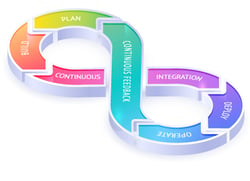 As increasing amounts of software are being integrated into hardware products, companies must do away with the traditional stage-gate methodology of planning, approving, and testing products and employ agile or hybrid systems instead. When such systems are in place, it is easier to align software and hardware roadmaps and follow a process that promotes success. Phasing out the stage-gate process for a hybrid approach allows for an adaptive strategy that accelerates development.
As increasing amounts of software are being integrated into hardware products, companies must do away with the traditional stage-gate methodology of planning, approving, and testing products and employ agile or hybrid systems instead. When such systems are in place, it is easier to align software and hardware roadmaps and follow a process that promotes success. Phasing out the stage-gate process for a hybrid approach allows for an adaptive strategy that accelerates development.
The Hardware Development Cycle
 Traditionally, manufacturers have used the stage-gate method for product planning and development. This process is largely tactical and used when designing complicated hardware that requires a large capital investment and takes time to build.
Traditionally, manufacturers have used the stage-gate method for product planning and development. This process is largely tactical and used when designing complicated hardware that requires a large capital investment and takes time to build.
The Design and Build Process: Stage-Gate
The stage-gate process for designing and building products follows a regular system:
- Engineers create a prototype
- The prototype design is tested
- Testing is complete, and the concept is approved for budget
- The development team builds a second prototype to reflect any changes to the product design
Each prototype that is built requires components from many suppliers, which must come together simultaneously, so coordination is critical. In the iteration phase, rebuilding and retooling the second prototype takes time, so fewer opportunities exist to change the physical device before bringing the product to market.
The Software Development Cycle
 While the development time for software can run anywhere from three to six months for simple functionality, it can also run from six to twelve months when designing more complex operating systems and feature-heavy programs. In either case, software development has a much shorter cycle compared to building hardware products.
While the development time for software can run anywhere from three to six months for simple functionality, it can also run from six to twelve months when designing more complex operating systems and feature-heavy programs. In either case, software development has a much shorter cycle compared to building hardware products.
The agile process takes an iterative approach where the engineer builds a feature, tests it, and then iterates before developing the next feature. The iteration process is also much more straightforward and might require a few hours to a few days for the engineer to write code. System software updates are also easy to develop and less expensive to fund.
The Challenges of Integrating Software into Hardware
Integrating software into hardware comes with many challenges. For starters, organizations using the stage-gate method will find that their processes are largely incompatible with software integration due to the following factors:
- The lengthy hardware development process
- The very rigid set of instructions in the development schedule
- The long iteration time for physical products
Hardware and software teams that function using the stage-gate process will experience the following problems:
- Software teams will complete their software build ahead of the hardware engineer's physical product
- Software may be left sitting on the shelf for several months
- Software teams have limited opportunities to collaborate and innovate
Software engineers don't want to wait several years before seeing their projects go to market. To retain talented software engineers, you need to accelerate the product development process.
This acceleration can be achieved by incorporating agile methods of production and bringing software designers into the hardware design and building process; after all, the hardware design needs to accommodate a range of software features that will improve the product's overall functionality.
Can Agility Help the Production Process?
 Agile frameworks are ideal when integrating software into hardware products and require replacing the traditional stage-gate methodology with a more flexible process that is highly adaptive. The hybrid approach takes the stage-gate idea and combines it with building a scaled-down model of the product, testing, approving, and iterating before moving on. For this new framework to be successful, the product manager must engage in the following processes.
Agile frameworks are ideal when integrating software into hardware products and require replacing the traditional stage-gate methodology with a more flexible process that is highly adaptive. The hybrid approach takes the stage-gate idea and combines it with building a scaled-down model of the product, testing, approving, and iterating before moving on. For this new framework to be successful, the product manager must engage in the following processes.
Concept Testing and Planning
The product manager needs to do due diligence in the initial concept design and testing phase to be sure the product is suitable for the market and the approved budget will be well spent.
Create a Minimum Viable Product
Instead of taking a year or more to build the first fully-functioning prototype and then testing it, a more efficient method focuses on the main features and builds just enough of the product to test them. When you work on building and improving one feature before moving on to the next, the costs and risks are much lower.
Sync Software and Hardware Roadmaps
This method is also better for software team members as they don't have to wait several years to learn how their software works. With this method, software engineers can work alongside hardware teams and synchronize their efforts to work together.
The Benefits of Scaled Agile
 Instead of utilizing agile systems across the entire organization, it may be easier to start by isolating the process to specific teams, known as scaled agile or hybrid. This allows the proper procedures to be implemented over time while gathering acceptance from internal stakeholders.
Instead of utilizing agile systems across the entire organization, it may be easier to start by isolating the process to specific teams, known as scaled agile or hybrid. This allows the proper procedures to be implemented over time while gathering acceptance from internal stakeholders.
Introducing agile methods into production offers several benefits for software and hardware teams.
- It opens up the lines of communication
- Promotes collaboration between development teams
- Improves morale and boosts productivity
- Allows for improved product design and flexibility
- Facilitates product innovation
- Reduces time to market
Why Do Agile Models Work So Well?
Shorter Iteration Cycles
By incorporating rapid stages that focus on developing a particular feature, hardware and software engineers can design, build, test, and iterate the product in real time before building the next feature.
Easy to Pivot and Make Changes
This method is easily adaptable at all stages, so you can incorporate software and hardware updates due to customer preference, technology advancements, and market changes as they happen.
Gain Valuable User Feedback
You can present your MVP to the customer at every stage to receive valuable feedback. Continuous experimentation when developing each feature leads to an improved product and increased innovation.
Faster Time to Market
The focus on developing individual features quickly, then testing and gaining approval rather than building an entire product and then iterating, helps to accelerate product development.
Use Product Roadmapping Tools to Align Software and Hardware Teams
 Product roadmap software allows you to map multiple roadmaps for software and hardware products along a separate timeline and integrate them to promote cross-collaborative functions.
Product roadmap software allows you to map multiple roadmaps for software and hardware products along a separate timeline and integrate them to promote cross-collaborative functions.
Maps Out Dependencies
A collaborative roadmap helps identify dependencies so teams know when features will be ready for integration and testing before getting started on the next stage. Program alerts are also helpful in notifying the relevant stakeholders of delays that may affect other milestones.
Improves Communication
By creating roadmaps that are accessible across the organization, your product teams gain insight and clarity as to what is happening in each stage of the process. This is particularly useful for the product manager overseeing the process to ensure product development is on track.
Invest in the Right Tools to Promote Agility
There are various roadmap templates available in product management tools that will help you streamline your processes and implement agility into your systems. If you want to find out how product roadmap management software can help you align your software and hardware teams, book your free demo with Gocious today.


